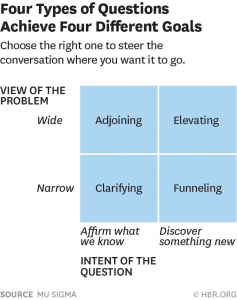With my work with Mathematical Modeling and Teaching practices, I think hard about the art of asking questions.
Harvard Business School article by Pohlmann and Thomas (2015) write about “Relearning the Art of Asking Questions” https://hbr.org/2015/03/relearning-the-art-of-asking-questions
The curious four-year-old asks a lot of questions — incessant streams of “Why?” and “Why not?” might sound familiar — but as we grow older, our questioning decreases. In a recent poll of more than 200 of our clients, we found that those with children estimated that 70-80% of their kids’ dialogues with others were comprised of questions. But those same clients said that only 15-25% of their own interactions consisted of questions. Why the drop off? They suggest these four types of questions to achieve 4 different goals. Clarifying, adjoining, funneling (or focusing since funneling has a negative connotation with PtA practices) and elevating. It makes me think about the math questions we ask in our math classrooms. Some view of the problem is wide and some narrow- when we are looking for patterns that is trying to look at a set of repeated reasoning or patterns (narrow) then to make a generalization or general rule for cases (wide). Often times, we are clarifying what students are thinking and affirming their thinking and other times we are extending their thinking to discover something new.
Clarifying questions help us better understand what has been said. In many conversations, people speak past one another. Asking clarifying questions can help uncover the real intent behind what is said. These help us understand each other better and lead us toward relevant follow-up questions. “Can you tell me more?” and “Why do you say so?” both fall into this category. People often don’t ask these questions, because they tend to make assumptions and complete any missing parts themselves.
Adjoining questions are used to explore related aspects of the problem that are ignored in the conversation. Questions such as, “How would this concept apply in a different context?” or “What are the related uses of this technology?” fall into this category. For example, asking “How would these insights apply in Canada?” during a discussion on customer life-time value in the U.S. can open a useful discussion on behavioral differences between customers in the U.S. and Canada. Our laser-like focus on immediate tasks often inhibits our asking more of these exploratory questions, but taking time to ask them can help us gain a broader understanding of something.
Funneling questions are used to dive deeper. We ask these to understand how an answer was derived, to challenge assumptions, and to understand the root causes of problems. Examples include: “How did you do the analysis?” and “Why did you not include this step?” Funneling can naturally follow the design of an organization and its offerings, such as, “Can we take this analysis of outdoor products and drive it down to a certain brand of lawn furniture?” Most analytical teams – especially those embedded in business operations – do an excellent job of using these questions.
Elevating questions raise broader issues and highlight the bigger picture. They help you zoom out. Being too immersed in an immediate problem makes it harder to see the overall context behind it. So you can ask, “Taking a step back, what are the larger issues?” or “Are we even addressing the right question?” For example, a discussion on issues like margin decline and decreasing customer satisfaction could turn into a broader discussion of corporate strategy with an elevating question: “Instead of talking about these issues separately, what are the larger trends we should be concerned about? How do they all tie together?” These questions take us to a higher playing field where we can better see connections between individual problems.
